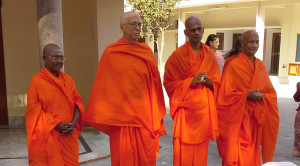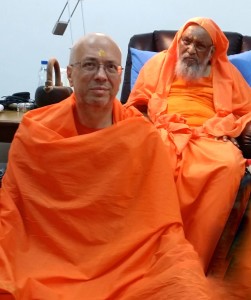Daksha Chaitanya was given Saṃnyāsa-Dīkṣā – initiation into the Daśanāmī monastic order – on March 22, 2015 in Rishikesh, India by Pujya Swami Dayananda Saraswati. Pujya Swamiji blessed him with the name Swami Advayatmananda Saraswati (स्वामी अद्वयात्मानन्द सरस्वती) – “One who finds his joy and completeness in the truth of the non-dual self from which nothing is separate.”
The vows taken by a saṃnyāsī, a Hindu monk, reflect his commitment to lead a simple life of non-injury, study, teaching, and contemplation. These vows of renunciation spring from the depths of one’s own vision of inherent inner freedom and fullness, and reveal the intention to fully express the wisdom and joy of the teachings of the ancient sages in one’s life .
The Initiation
The initiation activities span over two days, beginning the day before the main vows are taken with a shave and a purifying Gaṇgā-snānam (dip in the Ganges river). Another trip to the Gaṇgā for changing the yajñopavīta (sacred thread) is followed by tarpanā – offering libations of water to the sages, gods, and ancestors, said to bless seven generations back.
At the yajñaśāla, the building wherein most of the rituals will take place, pūjās to Ganesha (remover of obstacles), Navagraha (the universe), and Devī (Goddess) are performed – rituals to invoke the Lord’s grace to bless our coming lives as saṃnyāsīs. The elaborate aṣṭaśrāddha ritual was next – a ritual of final offerings of food to the departed forefathers, mothers, gods, rṣis (ancient sages), and elements. This includes the final funeral ceremony even for oneself, since the initiate will die to his old life to be transformed anew.
Mid-morning begins the chanting of Gāyatrī mantra, followed several hours later by Gāyatrī Homa, a prayer for brilliance in one’s knowledge and teaching. Chanting of Gāyatrī mantra and offerings into the sacred fire continue until sunrise the following day. Morning brings the performance of the powerful Viraja Homa, a ritual to purify all aspects of one’s being in preparation for saṃnyāsa.
Finally the formal Saṃnyāsa-dīkṣā (initiation) commences in which, with sun and moon, sky and earth, sunrise and sunset, the gods and sadhus as witnesses, all aspects of one’s previous life – one’s ego, personal history, possessions, all small pursuits and identifications, everything in this world and the next – are renounced. Then with an offering of water, the vow of ahiṃsā, to cause no harm to any living being is taken: Abhayaṃ sarvabhūtebhyo mattaḥ svāhā – For all living beings may there be no fear from me.
Then standing in the Gaṇgā, discarding his sacred thread and even his white clothing into the river, having abandoned all worldly aspirations, and in the spirit of total renunciation and freedom, the freshly-minted saṃnyāsī begins walking north, the north being a symbol of mokṣa, liberation. He is ceremonially called back by fellow sādhus who offer him the traditional orange robes of a monk. Pujya Swamiji then gives a new name which reflects one’s true nature, and the saṃnyāsa mantra. This is followed by the performance of a pādapūjā for Pujya Swamiji to honor the guru and the lineage.
Finally the new saṃnyāsīs journey to Kalikamaliwale Annakṣetra (a Rishikesh establishment that freely feeds hundreds of sādhus a day) for bhikṣā (taking alms), dal and roti, in the same manner as Pujya Swamiji did some 50 years ago.

Sannyasa Diksha March 22, 2015
Read about Swami Dayananda
Read about Swami Advayatmananda

